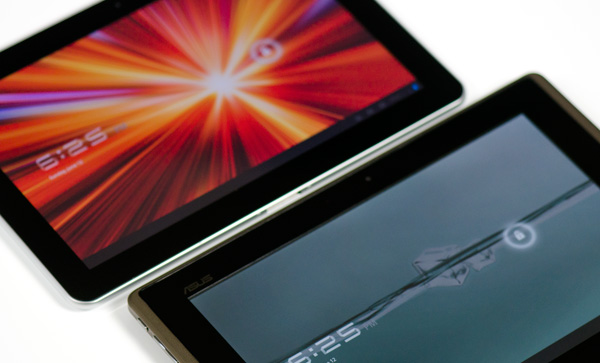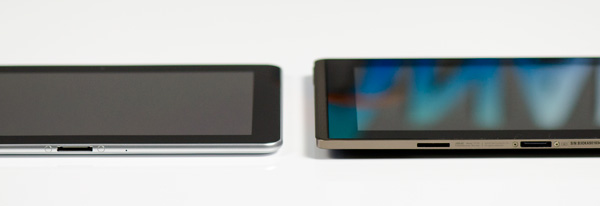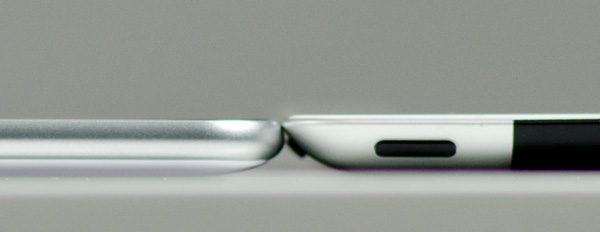Samsung Galaxy Tab 10.1 Review: The Sleekest Honeycomb Tablet
by Anand Lal Shimpi on June 13, 2011 5:07 AM EST- Posted in
- Tablets
- Samsung
- Tegra 2
- Galaxy tab 10.1
- Android 3.1
- Mobile
- NVIDIA
I remember standing in the audience of Samsung's CTIA press conference as it announced, for the first time ever, pricing and availability of its unreleased Galaxy Tab 10.1 and 8.9 before shipping. The smartphone (and early tablet) industries have gone this long without having to really compete based on price, mostly because in North America the carriers subsidize much of the cost. If every device costs $199 under contract, why get carried away with details like how much it actually costs?
The Galaxy Tab however was playing in a different space. While Apple ultimately caved to the pressures of carrier subsidies with the iPhone, the iPad remains completely unsubsidized and its followers buy it by the millions. The magical price point is $499 and it was at Samsung's CTIA press conference that it announced it would be matching Apple's $499 price point, and even dropping slightly below it for the 8.9-inch version.
At the time it seemed like a bold move, enough to give Honeycomb the fighting chance it needed. The Galaxy Tab would be thinner and lighter than the iPad 2 but competitively priced as well. This wouldn't be another Xoom.

Samsung Galaxy Tab 10.1 (top) vs. ASUS Eee Pad Transformer (bottom)
Then ASUS showed up. At $399, the Eee Pad Transformer not only offered a different usage model to the iPad and Galaxy Tab, it brought a lower price tag as well. Availability has been slim thanks to component shortages, but with the Eee Pad selling for $399 the Galaxy Tab at $499 all of the sudden seems overpriced.
| 2011 Tablet Comparison | ||||||
| Apple iPad 2 | ASUS Eee Pad Transformer | Motorola Xoom WiFi | Samsung Galaxy Tab 10.1 | |||
| SoC | Apple A5 (Dual ARM Cortex A9 @ 1GHz) | NVIDIA Tegra 2 (Dual ARM Cortex A9 @ 1GHz) | NVIDIA Tegra 2 (Dual ARM Cortex A9 @ 1GHz) | NVIDIA Tegra 2 (Dual ARM Cortex A9 @ 1GHz) | ||
| GPU | PowerVR SGX 543MP2 | NVIDIA GeForce | NVIDIA GeForce | NVIDIA GeForce | ||
| RAM | 512MB | 1GB | 1GB | 1GB | ||
| Display | 1024 x 768 IPS | 1280 x 800 IPS | 1280 x 800 | 1280 x 800 PLS | ||
| NAND | 16GB | 16GB | 32GB | 16GB | ||
| Dimensions | 241.2mm x 185.7mm x 8.8mm | 271mm x 175mm x 12.95mm | 249.1mm x 167.8mm x 12.9mm | 256.6 x 172.9 x 8.6mm | ||
| Weight | 601g | 695g | 730g | 565g | ||
| Price | $499 | $399 | $599 | $499 | ||
Based on specs alone you'd be right. Samsung's Galaxy Tab 10.1 has the same NVIDIA Tegra 2 tablet SoC inside,
1GB of LPDDR2 and 16GB of NAND on-board. You get a 10.1-inch 1280 x 800 PLS display and 802.11n WiFi support. It's worth pointing out that we're now well into the month of June and NVIDIA continues to be the only SoC vendor shipping in Honeycomb tablets. Samsung originally had plans to ship its own Exynos SoC in the Galaxy Tab but Tegra 2 remains the port of choice for all Honeycomb vendors at this point. Whether or not NVIDIA can win twice in a row with Ice Cream Sandwich later this year remains to be seen.

Samsung Galaxy Tab 10.1 (left) vs. ASUS Eee Pad Transformer (Right)
Where Samsung gives you something more for your money is in build quality and form factor. While Eee Pad Transformer feels surprisingly good for a cost reduced tablet, it doesn't feel nearly as slim or portable as the Galaxy Tab 10.1. It's no wonder Samsung went back to the drawing board on this one, the result is something that in many ways feels better than the iPad 2.
Apple still gets the nod in terms of quality of materials. The aluminum back of the iPad 2 is unbeatable. The Galaxy Tab 10.1 however feels lighter, a bit more rugged (I'm less concerned about scratching plastic than I am marring aluminum) and a little more comfortable to hold as a result. Against the Eee Pad there's no competition. I can live with the Eee Pad, but I much prefer the feel of the Galaxy Tab 10.1. The new Tab just feels like a device from this year - a compliment that, until now, I had only given to Apple.
The Galaxy Tab 10.1 measures just 8.6mm thick, 0.2mm thinner than the iPad 2. To be honest you really can't tell the difference, both devices feel thin. Ever after holding them back to back it's near impossible to tell that Samsung has built a thinner device. The most tangible difference in feel is the weight, not just in overall mass but in terms of weight distribution. The Galaxy Tab seems to carry the weight a bit better than the iPad, a bit more evenly.

Samsung Galaxy Tab 10.1 (left) vs. Apple iPad 2 (right)
Now is as good a time as any to point out that although Samsung calls this the Galaxy Tab 10.1, it's really the new Galaxy Tab 10.1. Originally Samsung announced a much thicker version at Mobile World Congress, a month prior to the CTIA announcement. With the much thinner iPad 2 hitting the market after the original 10.1 announcement, Samsung scrapped plans for the original and unveiled the thinner 8.6mm version as the new Galaxy Tab. The original Galaxy Tab 10.1 is now known as the Galaxy Tab 10.1v.












108 Comments
View All Comments
mikehunt80 - Monday, June 13, 2011 - link
Although it's true that the integer performance of Kal-El will be the same clock for clock as Tegra 2. The floating performance with quadruple thanks to the addition of Neon. This makes a big difference when working with complex surfaces, as well as decoding videos that aren't part of the hardware codec.Hrel - Monday, June 13, 2011 - link
I'm really sick of EVERYTHING being compared to the apple version of a similar product. Apple, IS NOT the golden standard. WAY WAY WAY back when the iphone first came out, ok sure. But ever since Android 2.0 was released Apple has been behind on every front.Start comparing the HTC's products or Motorola, like the Droid X. Asus E anything is a step above at least. Or better yet hold Apple to the standards of Archos. Superior build quality, superior functionality, more options and choices as well as being priced less than half as much. Yeah... can't even compete can you Apple. Fucking stupid people...
michael2k - Monday, June 13, 2011 - link
When the iPad can sell 3m in a month and #2 Acer sells 300k, Apple is still the golden standard.Conner_36 - Monday, June 13, 2011 - link
While Apple is selling the most tablets they are the golden standard, just like Google is the golden standard for search (find your own example of company with the significant market share is considered the 'golden' standard).vision33r - Monday, June 13, 2011 - link
When Apple is the one innovating, being 1st and selling millions. That's how gold standard is created.Show me which product Google released 1st other than search that was innovative and successful?
Android OS was conceived to battle iOS so Google can plant more ads without Apple's lock down.
ph00ny - Monday, June 13, 2011 - link
show me a single piece of hardware that apple has innovated that wasn't supplied by samsung, lg, etcBelard - Tuesday, June 14, 2011 - link
UH... what does that have to do with anything? First LG is really more of a brand than a manufacture. Samsung makes most of the LCD panels sold in the world... sound under dozens of names.Hate them or not... Apple did bring out the GUI computer, Smart phone and tablets to the consumer mass.
Jamestownsend - Tuesday, June 14, 2011 - link
Apple isn't a hardware company. Im more likely to call them a software/UI development company. Open any of their devices and you'll see stamps from other companies. they are what i call cherry pickers. they pick the best from everyone, combine it into a pretty case that they made themselves and sell it as an experience.fteoath64 - Wednesday, June 15, 2011 - link
Apple's magic is in their OS software. Their hardware components has been mediocre at best but their integration of the components into the design is their skill. Wrap this in easy-to-use UI/OS, they have a compelling product, hence, they can set the "Gold Standard" because they can cater for 80% of the people out there even with a higher price point.robco - Monday, June 13, 2011 - link
Apple was making the iPhone when there was no Android. They forced everyone else to step up their game. They've been pretty good about releasing new versions that adds new features. They didn't have everything out of the starting gate, but what they put in worked very well.This is where Apple and Google diverge into two opposite directions. Google has made web apps in the past. You can quickly add new features and tweak things. Their products are almost in a state of perpetual beta. GMail was labelled a beta for years. They have no problem adapting new technologies, even if they aren't polished. Apple OTOH tends to pick and choose what it will implement more carefully and won't put a feature into a product until it meets their standards. If you want to be bleeding edge and buzzword-compliant, then Apple products are not for you.
For Apple, it's not just about what the product does, it's about what it does well. I've seen some really nice Android devices, but some of the third-party UIs seem a bit clunky and some of the features are still half-baked. They're differing philosophies. Some people want something that just works, others don't mind getting new features early even if they aren't quite neat and tidy. Neither are wrong, just different.